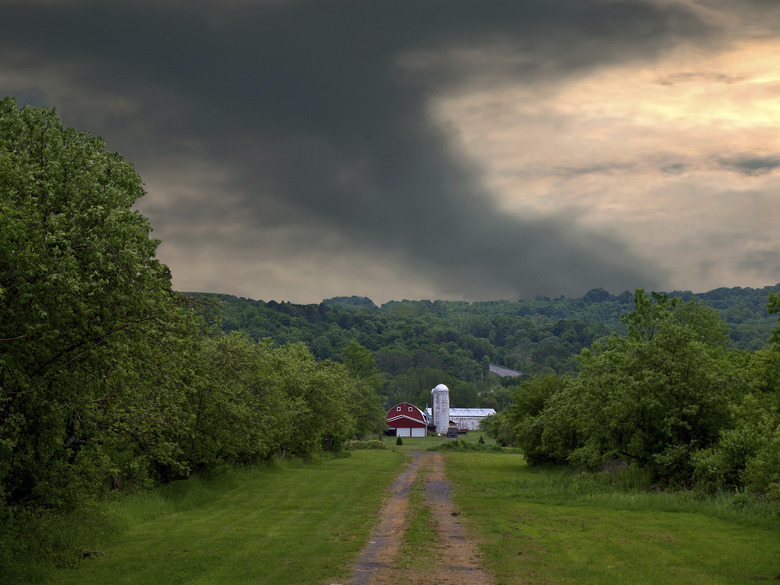The Difference Between Tornadoes & Hurricanes
Tornadoes and hurricanes both have the potential to cause extensive damage, but they are two different types of storms. An important difference is their relative size: a hurricane is easily visible from space because it covers a significant portion of Earth's surface. A tornado, on the other hand, is seldom visible from space because it is smaller and hidden under the clouds from which it formed. Of the two types of storms, tornadoes have the faster wind speeds.
Hurricane and Tornado Formation
Hurricane and Tornado Formation
A hurricane forms over tropical oceans in which the water is at least 27 degrees Celsius (80 degrees Fahrenheit). Warm, moist air rising into the upper troposphere and driven by strong tropical winds creates low pressure at sea level. Air from the surroundings rushes in to equalize the pressure and also rises, while cold air from the top of the weather system drops, eventually producing the characteristic round, spiraling shape of the storm. A tornado forms over land in large thunderstorm clouds. The funnel-shaped cloud that eventually touches down as a tornado is the result of horizontal wind shear between two different pressure areas in the cloud.
Size and Duration
Size and Duration
When a tornado touches down, the diameter of its funnel is seldom more than 500 meters (0.25 miles) across; the largest funnel ever recorded was 4 kilometers (2.5 miles) across. A hurricane is large enough to affect entire states or small countries; hurricanes are typically 100 miles across, but some can grow to such a size that they subject an area 500 miles across to gale-force winds. A hurricane can last days or weeks, but a tornado is generally a short-lived phenomenon that typically lasts no more than an hour.
Wind Speeds
Wind Speeds
A tropical storm becomes a hurricane when the winds within it reach a speed of at least 119 kilometers per hour (74 miles per hour), but a category 5 hurricane, the strongest type, has winds in excess of 250 kilometers per hour (155 miles per hour). Winds on the circumference of a tornado's funnel-shaped cloud blow faster. The strongest tornadoes have winds that blow at speeds of 483 kilometers per hour (300 miles per hour) or more. Tornadoes with these maximum wind speeds are examples of F5 tornadoes on the Fujita-Pearson, or F, scale. At the low end of the scale, an F0 tornado has winds of 64–166 kilometers per hour (40–72 miles per hour).
Destructive Potential
Destructive Potential
Hurricane Katrina, the costliest hurricane in U.S. history, caused $108 billion dollars in damage. It passed over Florida as a category 1 hurricane but picked up energy in the Gulf of Mexico to become a category 5 storm before striking the Gulf Coast. In contrast, the damage caused by the most destructive tornado in U.S. history, which struck the town of Joplin, Missouri in 2011, resulted in only about 3 percent of the damage that Katrina caused. This discrepancy underscores the fact that hurricanes such as Katrina are larger and longer-lasting storms than tornadoes.
Cite This Article
MLA
Deziel, Chris. "The Difference Between Tornadoes & Hurricanes" sciencing.com, https://www.sciencing.com/difference-between-tornadoes-hurricanes-8454967/. 24 September 2021.
APA
Deziel, Chris. (2021, September 24). The Difference Between Tornadoes & Hurricanes. sciencing.com. Retrieved from https://www.sciencing.com/difference-between-tornadoes-hurricanes-8454967/
Chicago
Deziel, Chris. The Difference Between Tornadoes & Hurricanes last modified March 24, 2022. https://www.sciencing.com/difference-between-tornadoes-hurricanes-8454967/
